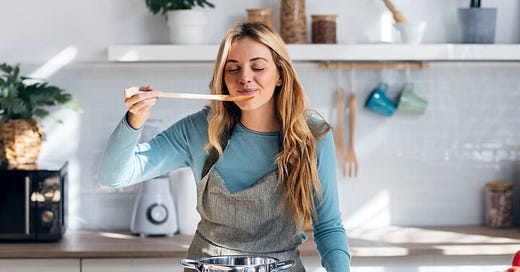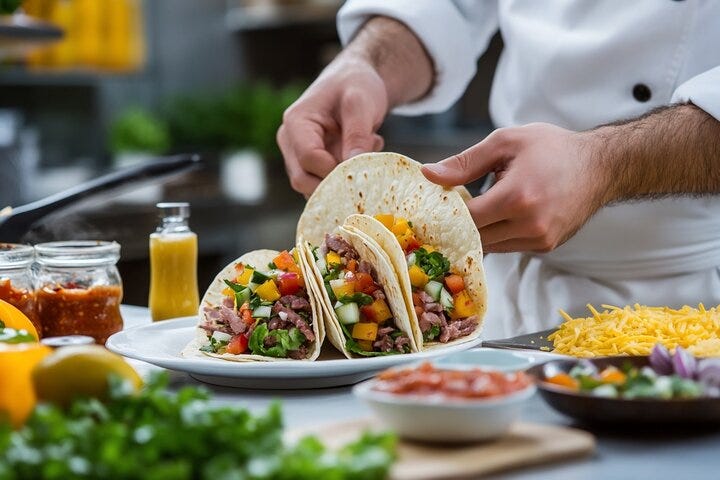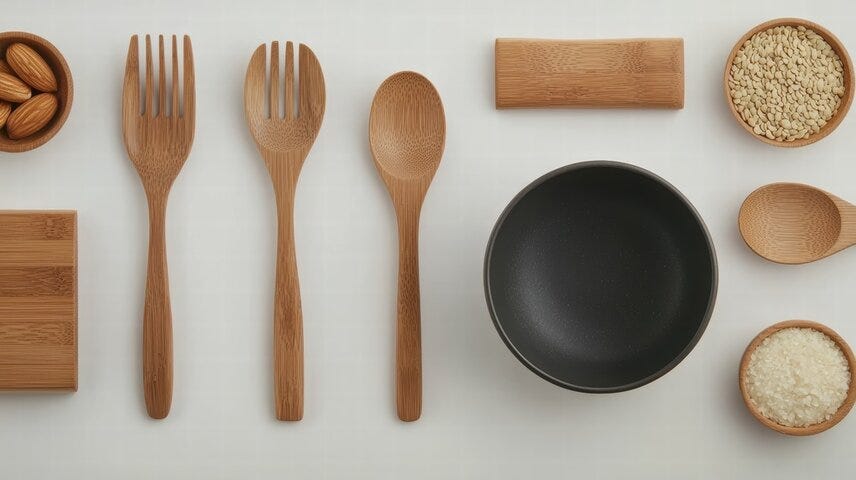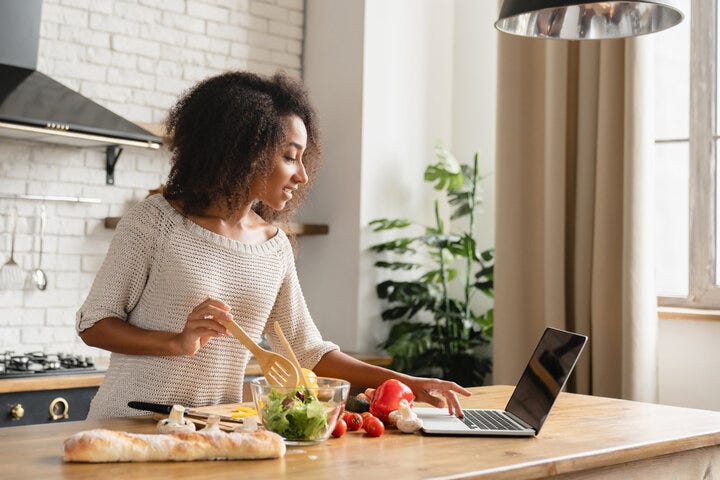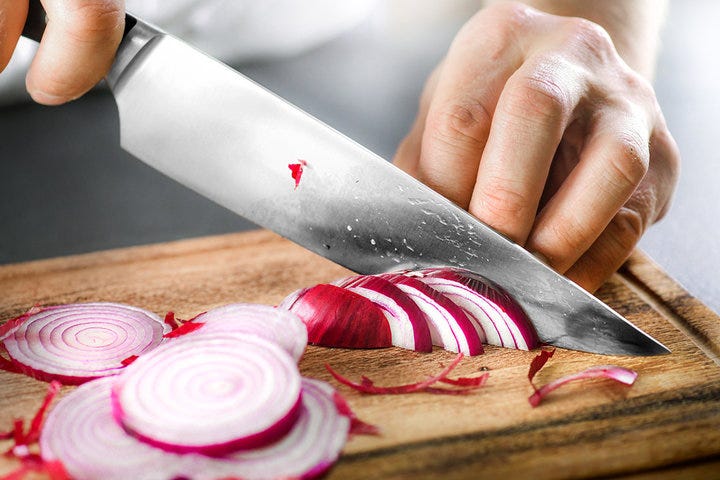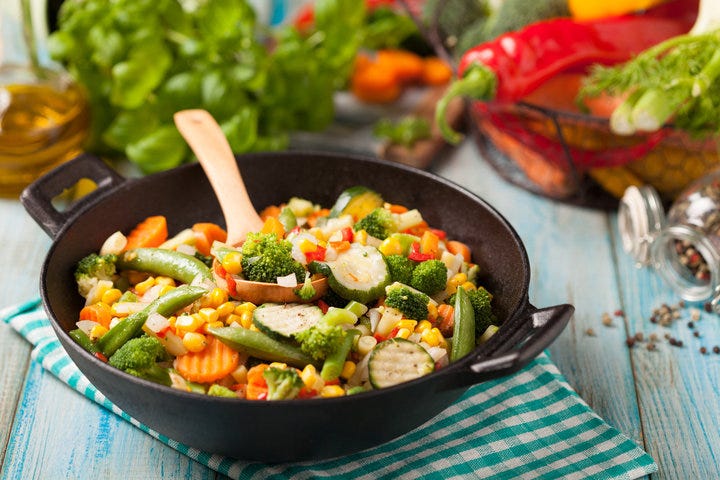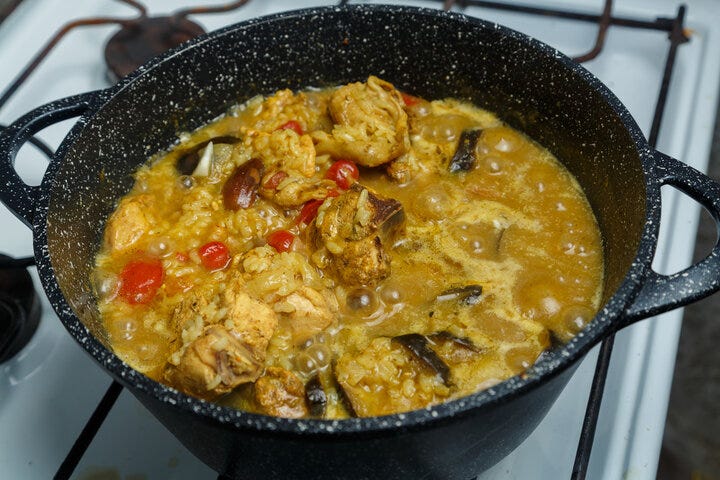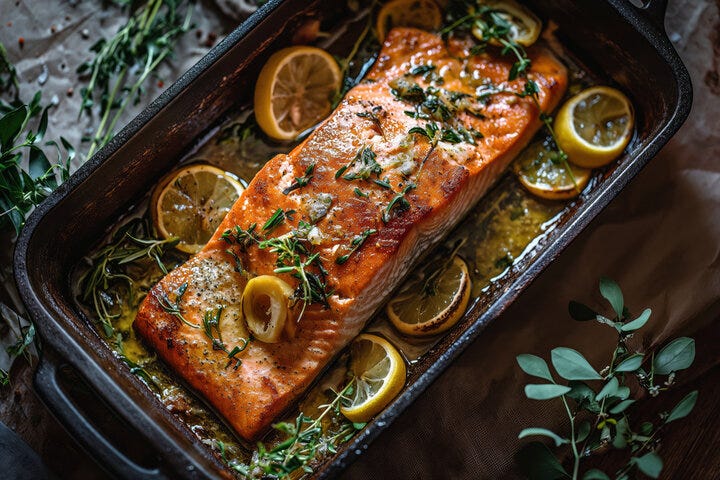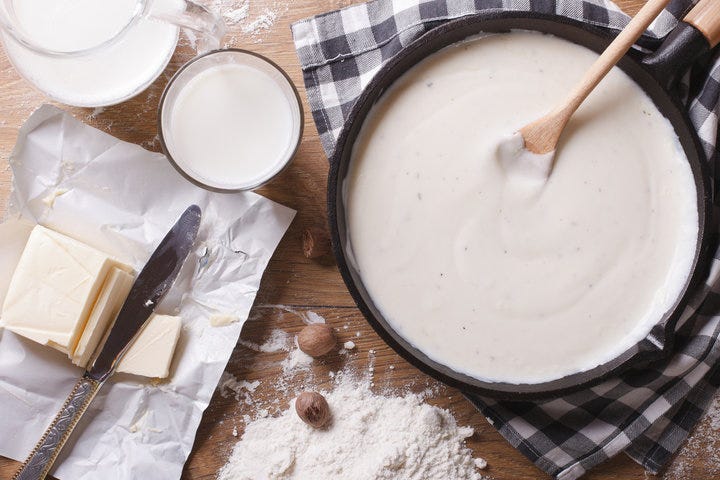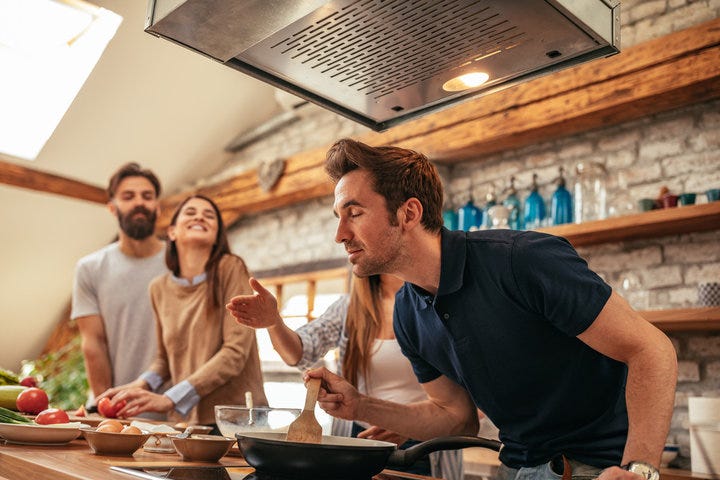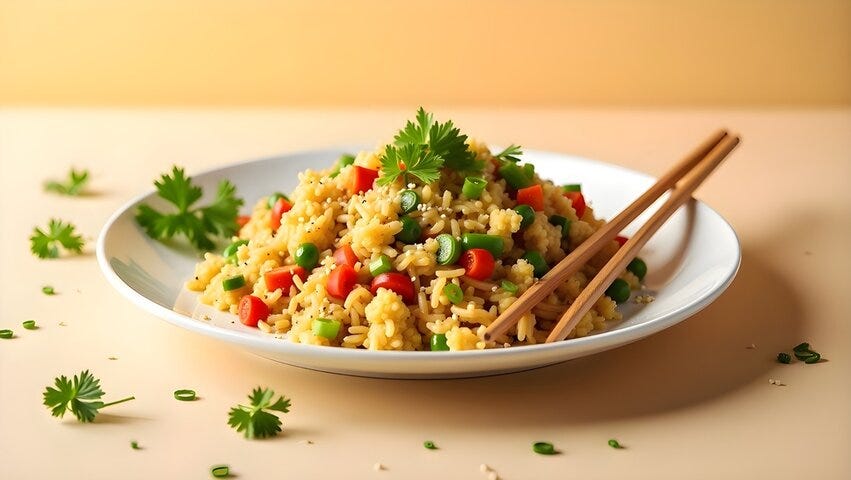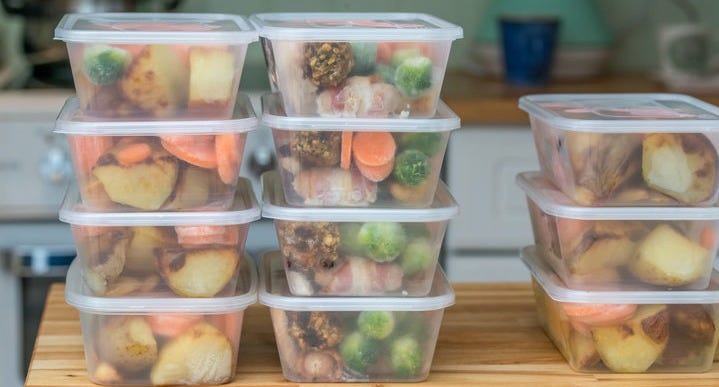Don’t Know How to Cook? This Is Where You Start 🍳
Editor’s Note
Hey friend! 👋
Frozen pizza and DoorDash get old (and pricey) fast. But between confusing recipes, TikTok chef hacks, and the idea that you need 40 gadgets to make dinner, it’s easy to feel like cooking’s not worth the effort. The good news is that most of that pressure is totally overhyped. Cooking can be fun, cheap, and surprisingly doable, no matter your situation!
This week’s newsletter is your no-pressure, no-judgment entry point into real-life cooking. Not gourmet 👨🍳. Not influencer-perfect 💅. Just solid, satisfying meals you can make — even if your kitchen is the size of a shoebox 📦, your budget is tighter than your jeans after Thanksgiving 🦃, and your schedule is a 3-ring circus 🎪.
We're breaking down why cooking’s worth figuring out, what basic tools you need, how to follow a recipe, and how to avoid beginner mistakes. 👇 Be sure to check out the Weekly Challenge! 🚀
Cheers,
The Picoast AI Team 💬💸
📢 Picoast is now in app stores!
Picoast is your daily system for building real-world skills, strong habits, and lasting confidence—with just a few minutes a day.
Whether you’re starting college, juggling work and school, or just trying to stay on top of life, Picoast helps you stay focused, make smart choices, manage money, and feel ready for whatever comes your way.
It’s like having a coach in your pocket—practical, flexible, and always there when you need it.
🌟Early users get FREE premium access through 2025!
👉Do you use Instagram or YouTube? It would be awesome if you could follow us at @picoastai for daily tips!
Basic Cooking Skills Everyone Should Have 🍴
You don’t need to love cooking. You don’t even need to be good at it (yet). But knowing how to cook a few meals changes everything 🧂💡
This guide is here to help you get started: how to set up your kitchen, follow a recipe, handle food safely, and avoid the classic “oops I used salt instead of sugar” moment.
Let’s get you cooking — for real this time.
No time to read all the tips? Here’s the TL;DR: 📱💪
🧭 Learn to cook. It’s a life skill that saves money, supports your health, and makes you feel more in control.
🍴 Good food isn’t fancy — it’s balanced. Learn how flavor (salt, fat, acid, heat), texture (crunch + soft), and basic nutrition come together.
🛠️ You only need a few tools. A sharp knife, a skillet, a pot, and pantry basics go a long way. Skip the 20-piece kitchen sets.
📋 Read the recipe first, prep your ingredients, and taste as you go. Most mistakes happen from rushing or skipping steps — not because you’re “bad at cooking.”
🔥 Practice a few techniques at a time — like sautéing, seasoning, folding, or thickening. These are what make food good (and fix it when it’s going wrong).
🧊 Store food safely, clean as you go, and learn a few rescue moves. Cooking fails happen. What matters is knowing how to recover.
🥚 Start small. Cook 2–3 real meals a week. Scrambled eggs, pasta, stir-fried rice — repeat until confident, then start adding.
🧭 Why Learn to Cook at All?
Most of us didn’t learn how to cook in school. And unless you had a parent who loved teaching the difference between sautéing and simmering, chances are you hit adulthood still unsure what half your kitchen tools actually do.
So why even bother learning now?
Because knowing how to cook gives you freedom. It means you’re not stuck spending money 💸 you don’t have on takeout. It means you can eat better without going on a diet or counting macros. It means you can take care of your health 💖— physically and mentally — with food that actually feels good to eat.
Cooking is also customizable. It can be fast and basic, or slow and creative. It can be just for you, or a social 🧑🤝🧑 experience you share with roommates, friends, or someone you’re trying to impress. You’re in charge. You decide how far you take it.
And maybe most importantly: when you start to cook for yourself, even just a few times a week, your confidence 😎 grows. You feel more in control of your time, your money, and your health.
🎯 What Makes Food “Good”?
Forget trends and gourmet jargon. All good food comes down to a few key ideas:
🧂 Flavor: It tastes good
Flavor is built from layers. Most great dishes have four elements working together:
Salt 🧂: Sharpens everything. If your food tastes “meh,” it probably needs salt.
Fat 🧈: Carries flavor and makes things rich (think olive oil, butter, coconut milk).
Acid 🍋: Brightens and cuts richness. Add lemon, vinegar, tomatoes, or pickles to wake up heavy dishes.
Heat 🔥: As in high temperature. It brings depth and texture . Roasting = rich and caramelized. Steaming = clean and light. Pan-searing = deep, crispy flavor. Simmering = mellow and deep. Grilling = smoky and crisp. Learning how cooking methods affect flavor is half the battle.
Umami: Adds satisfying depth. It’s savory backbone soy sauce, mushrooms, Parmesan
Aromatics: For scent. Garlic, ginger, etc.
👉 Once you know how these work together, you can fix boring food on the spot.
🍽 Texture: It feels good to eat
A good meal has contrast: crispy with soft, chewy with creamy. Avoid the “everything is mush” problem by mixing textures — top a soup with nuts or toast, or serve a grain bowl with something pickled or crunchy.
Examples:
Soup + crusty bread
Roasted sweet potatoes + lime + toasted seeds
Mac and cheese with hot sauce and crushed chips on top 🧀🔥
If everything is one soft note (think boiled vegetables and mushy rice), your brain checks out. Add a crunch, a drizzle, or a squeeze to mix it up.
🥦 Nutrition: It keeps you full without the guilt
A good meal usually just needs:
A protein (eggs, tofu, lentils, meat, fish)
A carb (rice, pasta, bread, potatoes)
A veg or fruit (raw, cooked, frozen — whatever works)
A bit of fat, preferably a healthy one (oil, avocado, peanut butter, nuts)
Build meals with those four, and you’re golden.
Set Up Your Kitchen 🛠️
Let’s get one thing straight: you don’t need a Pinterest-worthy kitchen or a drawer full of uni-taskers you saw in a BuzzFeed listicle. You need a few solid basics that work and don’t make you want to scream mid-meal.
Here’s the real starter pack:
🧰 Must-have tools
Chef’s knife (8–10") 🔪 – the one tool that makes everything else easier (and safer).
Cutting board (wood lasts; plastic is dishwasher‑safe) – one that won’t slide around.
Nonstick skillet (10”) 🍳 – for eggs, stir-fries, pancakes, and quick dinners.
Saucepan with lid (3qt) – perfect for rice, pasta, frozen veggies, soups.
Sheet pan (if you have an oven; 18×13 in fits most ovens)– roasting anything = fewer dishes + more flavor.
Spatula, wooden spoon, tongs – your go-to stir/flipping tools.
Measuring cups and spoons – because “just eyeball it” only works when you’ve messed it up a few times already 😅.
Can opener 🥫
Mixing bowls – use for tossing, prepping, or pretending you're on a cooking show.
Colander – draining pasta without it = disaster.
Blender – only if you like to make smoothies, soups, sauces.
Peeler, grater, whisk – super useful, but skip if you never need them.
Instant‑read thermometer – helpful to make sure your meat is safe to eat.
Oven mitts
Bonus: Rice cooker or multi‑cooker (like an Instant Pot) – Great for dorms.
📦 Pantry & fridge
Dry staples: Rice, pasta, quinoa, rolled oats, lentils, flour, sugar, instant yeast.
Canned / jarred: Beans, chickpeas, crushed tomatoes, tuna, broth concentrate.
Condiments & spices: Olive + neutral oil, soy sauce, hot sauce, Dijon, vinegar, cumin, dried oregano, cinnamon.
Fridge / freezer: Eggs, cheese, frozen chicken breasts, tofu, milk, plain yogurt, lemons/limes, carrots, onions, garlic, frozen veg, frozen berries.
👉 With these you can knock out: veggie fried rice, chili, pasta puttanesca, shakshuka, sheet‑pan fajitas.
💰 Budget tips
You do not need a full knife block. Get one good chef’s knife and keep it sharp.
Dollar stores often have solid basics. Same with thrift stores.
Look for multi-use tools. A sheet pan can roast an entire dinner.
Don’t fall for the “starter kit” trap. Half of that stuff collects dust.
🧼 Storage hacks
Keep your most-used utensils near the stove.
Stash a damp cloth under your cutting board to stop slipping.
Keep spices where you can see them. If they’re buried, you won’t use them.
🧑🍳 Cooking in a tiny or shared kitchen?
Been there. You don’t need a full stove to cook real food.
Microwave + rice cooker or multi-cooker = magic combo 🍚🔥
Electric kettle hacks - Couscous, instant oatmeal, ramen upgrade.
Stick to one-pot meals (chili, curry, pasta)
Clean as you go. Shared kitchens get chaotic fast.
Prep during off-peak hours if you have roommates
Label your stuff, and don’t be shy about guarding your snacks 😤
Follow the Recipe 📋
Ever started cooking, only to realize halfway through you’re supposed to marinate the chicken overnight, soak the beans for 12 hours, and own a stand mixer? Yeah. Don’t be that person.
Read the whole thing first ✅: Sounds obvious, but so many people skip this. Know what tools you need, what ingredients need prepping, and if there’s a “wait 30 mins” surprise hiding at the end.
Swap ingredients if you need to: Missing an ingredient? Google or ask Life Guru for an adequate substitute. Example: 1 cup buttermilk ↔ 1 cup milk + 1 Tbsp vinegar (5 min rest).
Measure well: Use measuring cups and measuring spoons. For baking, a scale is worth the investment.
Do your mise en place ⚙️ : That’s chef-speak for “get your sh*t together.” Chop everything. Measure stuff. Get it all in little bowls.
Follow the sequence ⏱️ : Yes, it matters. If the recipe says to sauté onions before adding garlic, there’s probably a reason (burnt garlic is gross and ruins everything).
Temperature matters: Preheat the oven or stovetop to the required temperature before you start cooking. Test the meat temp.
Taste as you go 👅 : Unless you’re baking — then don’t. But for cooking? Taste and adjust. Salt, acid, spice. Little tweaks make a huge difference.
Scaling? Doubling the recipe? Double everything. Not just the chicken. Forgetting to adjust salt or liquid ruins the whole thing. If the math trips you up, search “recipe scaling calculator” — or just use your calculator app.
Make notes 📓 : Write down what worked. Or what didn’t. Or how you saved that one burnt mess with lemon juice. You’re not going to remember next week — and you’ll be glad you wrote it down.
💡 Read reviews before you commit to a recipe. Even a great website can have a dud recipe. Check the comments — they’ll tell you if something’s off, or if it takes twice as long as promised.
Learn Food Prep Techniques First
You don’t need a masterclass to learn how to cook real meals. You just need to get familiar with a few techniques — and how to not destroy your ingredients along the way.
🪓 Knife skills
The faster you learn to handle a knife, the faster everything else gets. Uniform pieces cook at the same rate, texture feels intentional, and prep goes faster over time. And no — you don’t need three knives. You need one sharp chef’s knife and the ability to use it without fear.
Mince (super small, < ⅛″): for garlic and herbs. Rest the tip on the board, rock the blade over the pile, sliding forward and back.
Dice (small ¼–½″ cubes): for onions, potatoes, carrots. Cut lengthwise into planks, stack, then cross-cut evenly.
Julienne (⅛″×2″ sticks): perfect for quick-cooking stir-fries. Trim both ends, square the vegetable (zucchini, bell peppers) into a barrel shape, slice thin planks, stack, and cut into sticks.
Chiffonade (thin ribbons): for basil and leafy greens. Stack leaves, roll into a tight cylinder, and slice across into fine strips.
🧼 Safety tip: Pinch grip the blade; tuck your fingertips (claw) if you like your fingers. Sharpen the knife often—a dull knife is more dangerous.
Other prep skills that make cooking way easier
Washing & drying produce 🥬: Sounds boring. Still important. Wet greens don’t sauté well — they steam and go soggy. Use a salad spinner or pat them dry with a towel.
Measuring: Eyeballing is fine for soup. But baking? You need to measure — properly. Level off dry ingredients. Use liquid measuring cups for liquids. For real accuracy, use grams and a kitchen scale.
Cracking eggs 🥚: Crack on a flat surface, not the edge of a bowl. Want zero mess? Crack into a ramekin first, then pour it into your pan or bowl.
Zesting and peeling 🍋: Use a microplane or fine grater for citrus zest (just the colorful part, not the bitter white layer). A Y-peeler is fastest for carrots, potatoes, and apples. Go slow and steady.
Mixing & whisking 🥣 : Whisking is in wrist control. Big bowl, small whisk, fast circles = fewer lumps. For dry and wet mixes (like pancakes), mix the dry, mix the wet, then combine.
Thawing frozen stuff 🧊 : Pull it out before you start cooking. Thaw in the fridge if you have time. If not, use cold water (sealed bag only) or microwave on defrost — but keep an eye on it.
Marinating (for flavor) 🧴: Soaking meat, tofu, or veggies in a mix of oil, acid (like vinegar or citrus), herbs, and spices helps them absorb flavor before cooking. Give it at least 30 minutes in the fridge — or overnight if you plan ahead. 💡 Don’t reuse marinade that touched raw meat unless you boil it first.
Blanching (for control) ♨️ : Blanching = dunking food in boiling water for a minute or two, then into ice water. It softens just enough to make peeling easier (hello, tomatoes), brightens veggies, or preps food for stir-frying or freezing. 🧠 Especially useful for broccoli, green beans, or anything that needs a little softening but not a full cook.
Seasoning 🌿 : Just salt, pepper, and one or two herbs go a long way. Season your ingredients before cooking — not just at the end.
Learn Heat techniques Next 🍳
Different cooking methods give you different textures, flavors, and vibes. Here’s how to pick the right one.
🔥 Fast cooking + crisp edges (high heat)
Sautéing (medium-high): Pan. Oil. Toss in food when the oil shimmers. Stir regularly so nothing sticks. Use this when: cooking veggies, eggs, shrimp, thin meats — anything that cooks quickly.
Stir-frying (high heat): Like sautéing, but faster and hotter. Cook in batches. Toss constantly. Use this when: you want crispy edges and speed. Great for small, uniform-cut ingredients.
Searing + oven finish: Get a dark crust in a hot pan, then move to the oven to finish cooking through. Use this when: cooking thick steaks, pork chops, or anything that needs a crispy outside and juicy middle.
Broiling: Direct heat from above. Fast, intense, no turning. Use this when: you want to brown or char something quickly (like finishing mac and cheese or crisping tofu).
💧 Tender, juicy, or gentle cooking (moist heat)
Boiling + simmering: Boiling = full rolling bubbles. Simmering = soft, gentle bubbles. Use this when: making pasta, rice, soups, stews — anything that cooks in water or broth.
Poaching: Gently cooking in liquid just under a boil. Use this when: making delicate foods like eggs or fish.
Steaming: No direct contact with water — just steam. Use this when: you want clean, bright veggies or soft fish without oil.
Braising: Sear the food (dark crust in a hot pan), then cook low and slow in liquid. Use this when: working with tougher cuts of meat or hearty veg. Makes them fall-apart tender.
Stewing: Like braising, but everything’s submerged. Use this when: making cozy, slow-cooked dishes with lots of liquid (soups, curries, chili).
Slow cooking: Low heat over several hours (crockpot/slow cooker). Use this when: you want to set it and forget it. Good for meal prep or hands-off dinner.
Pressure cooking: High steam pressure = faster cooking. Use this when: you're short on time but want the results of slow cooking.
Low heat cooking: Use it when you want gentle cooking — like eggs, melty cheese, or sauces that shouldn't split. If the pan’s too hot, pull it off the heat for a sec and stir.
🔥 Caramelized, crispy, golden brown vibes (dry heat)
Roasting (400–450°F): Cooks food evenly with crispy edges. 👀 Tip: Add dense stuff (like carrots) earlier than soft stuff (like zucchini). Use this when: making sheet-pan meals, roasted veg, or proteins.
Baking: Uses dry oven heat, but for different textures — not crispy, but set or fluffy. Use this when: making bread, muffins, cakes, casseroles.
Grilling: Open flame or grill pan. Charred, smoky results. Use this when: you want big flavor fast. Great for meats, veggies, skewers.
Barbecuing: Slow, indirect grilling. Think ribs, pulled pork — needs time and low heat. Use this when: you’re outdoors and in no rush.
Smoking: Cooks food slowly with wood or charcoal smoke. Use this when: you want bold, smoky flavor. Usually for meat or cheese. Not apartment-friendly.
Frying: Cook in oil — shallow (pan-frying) or deep. Crispy outside, soft inside. Use this when: making cutlets, fritters, or anything battered.
Learn to Cook for Texture 🥣
You know how to prep your ingredients and how to cook them with heat. But how you work with ingredients in between — combining, mixing, thickening, smoothing — can make a huge difference. This is where texture gets handled, sauces come together instead of separating, and you stop asking “Why is this still watery?” or “Why did the eggs curdle?”
🍝 Sauce-making moves (flavor + texture)
Reduce🔥: Simmer a sauce or broth until it thickens and the flavors concentrate. Use when: a sauce is too thin or needs more flavor. Think: pasta sauce, pan drippings, or broth that tastes bland.
Emulsify 🧴: Combine two things that don’t mix (like oil and vinegar) into one smooth liquid. Use when: making salad dressings, aioli, or creamy sauces. Whisking steadily helps it hold.
Deglaze 🥄: Pour a bit of liquid into a hot pan after searing to loosen the browned bits (a.k.a. flavor gold). Use when: you want a quick, rich sauce without starting from scratch.
🧠 Stabilizing + controlling texture
Temper 🔥: Add hot liquid slowly into a cold one to warm it up without curdling. Use when: mixing eggs into hot soup, or blending dairy into sauces.
Whisk + stir 🥣: Whisking adds air and smooths lumps. Stirring combines ingredients evenly. Use when: mixing batter, eggs, sauces, or anything you want smooth (not clumpy).
Gentle stirring 🌀: Some recipes need a soft touch. Stirring too hard can deflate batters, break emulsions, or wreck textures (like creamy eggs). Use a spatula or spoon and mix just until combined.
Fold 💨: Gently combine airy and heavy ingredients without flattening the texture. Use when: making fluffy pancakes, whipped cream, or anything you want to stay light.
Thicken with starch 🌽: Mix a small amount of flour, cornstarch, or arrowroot with cold water (a slurry), then stir into hot liquid. Use when: you want to thicken a soup or sauce without reducing it for 30 minutes.
Stretch with pasta water 💧: That starchy water from boiling pasta? Add a splash to sauces (especially tomato or butter-based) to make them glossy and clingy.
🍲 Smoothing & Refining
Puree + Strain 🍲: Pureeing blends everything smooth. Straining removes leftover bits. Use when: making creamy soups, velvety sauces, or when texture matters (hello, hummus).
Whip for air 💨: Use a whisk, electric mixer, or stand mixer to add volume through air. Use when: making whipped cream, meringue, or light desserts that rely on structure and fluff.
Learn to Build Flavor 🌶️
Most home cooking tastes bland because no one teaches you how to layer flavor. It’s not magic — it’s repetition and knowing your pillars:
Start with aromatics 🔥: Before you throw anything else in the pan, sauté chopped onions, garlic, or ginger in a bit of oil. Go slow. Let them soften and smell amazing. This is your flavor base — skip it, and the whole dish tastes flat. 👀 Watch the garlic — it burns fast. Once it turns golden, move on.
Deglaze for depth 🍷 : After browning meat or veg, there’s a layer stuck to the pan (called fond). Don’t wipe it out — pour in a little liquid (broth, wine, vinegar, even water) and scrape it up. That’s concentrated flavor. Let it reduce a bit, then keep cooking.
Season in layers 🧂: Don’t wait until the end to throw salt on top. Add a pinch as you go — after sautéing, after deglazing, before simmering. Seasoning early and often lets the flavor actually sink in. 🧠 Tip: If you’re cooking grains or pasta, salt the water like you mean it.
Taste and adjust at the end 🍋 : At the end of cooking, taste your dish and ask: does it feel dull or too heavy? Try a splash of acid like lemon, vinegar, or lime. Still feels dry? Add a little butter or olive oil. Is it too sharp? Add a touch of sugar or cream. Too bland? Add salt, more fat, or a pinch of spice. Still boring? Try a fresh herb or chili flake sprinkle. You’ll be shocked how fast it transforms.
🎯 The point is: don’t wait for flavor to show up. Build it with every step.
Cook like the flavor depends on you — because it literally does. And your kitchen will smell like you know what you’re doing 👃.
Handle and Store Food Like a Pro
Cooking’s great. Food poisoning? Not so much.
This part gets skipped way too often — and that’s where people end up with moldy rice, weird-smelling chicken, or that one roommate who never labels anything. Let’s fix that:
⚠️ Safety basics
Separate raw meat from everything else. Use a different cutting board if you can. If not? Wash it like a surgeon 🧼
Wash your hands after handling raw meat, eggs, fish, or anything sketchy
Cook meat fully: use a thermometer (Google or ask Life Guru the temp for your protein)
Don't leave food out more than 2 hours (yes, even if it's cold pizza)
Fridge = airtight containers. Label with the date so you know what’s still edible
Oil splatters fast — especially when water hits hot oil. Use a splatter guard if you have one, and don’t stand over the pan in shorts 🙃
Clean as you go: not just for tidiness — spills and greasy messes = slipping hazards and bacteria magnets
Sharpen your knives!
Pay attention at the stove: Turn the pan handle in. Lift lids away to dodge steam burns. Never leave hot oil unattended—fire risk is real.
💡 Shared fridge tip: Keep your stuff in one bin. It’s cleaner, safer, and less likely to “go missing.”
🧺 Leftovers: Store ‘em smart
Glass containers are better than plastic (especially for hot foods)
Freeze extra meals in single portions. They’ll last longer and save you when you’re tired/hungover/broke
Always rotate older food to the front so it actually gets eaten
Label your containers — trust us, your future self doesn’t know what’s in that mystery tupperware
Fix Common Mistakes 🛠️
Cooking fails aren’t a crisis. They’re your best teachers. Let’s run through the kitchen damage control playbook:
Too salty? ➡️ Add lemon juice, plain yogurt, water, or a peeled potato 🥔
Too spicy? ➡️ Stir in coconut milk, sour cream, or a tiny pinch of sugar
Burned the bottom of the pot? ➡️ Don’t scrape it. Scoop the good stuff into a clean pan
Overcooked pasta? ➡️ Rinse under cold water to stop it cooking, then crisp it in a pan with garlic and olive oil
Forgot a key ingredient? ➡️ Google a swap or lean into the chaos.
Eggs stuck to the pan? ➡️ Soak the pan, use nonstick or more oil next time, and cook on lower heat
Chicken is raw in the middle? ➡️ Cut it into smaller pieces and keep cooking on medium
Pasta water overflowed? ➡️ Next time, use a bigger pot and stir once it boils — and don’t walk away
Baking stuck to the pan? ➡️ Let it cool first. Run a knife around the edges. Next time: grease better
Soup tastes bland? ➡️ Add salt, a bouillon cube, or a splash of lemon or vinegar
Pan is smoking? ➡️ Take it off the heat. It’s too hot. Lower and try again
Used too much oil? ➡️ Spoon some out or blot with a paper towel
Spilled oil or sauce? ➡️ Clean as you go — slippery floors = danger zone
💡 Tip: Keep your cool. Turn down the heat. Stir slower. Walk away if you need to. Most things aren’t ruined — they’re recoverable.
Start Small, Cook Often 🔁
Don’t try to become a kitchen wizard overnight. Pick a few basic meals, cook them a couple of times, and use them as your foundation. The goal isn’t to get fancy— you’re building muscle memory.
Here are 5 starter meals worth repeating. Each one teaches a different skill — and once you’ve got them down, you can start remixing.
🥚 Scrambled eggs + toast
Whisk eggs with a pinch of salt, cook low and slow in butter, stir gently until just set.
Teaches: Low heat control, gentle stirring, timing
Next up: Omelets, frittatas, breakfast sandwiches
🥕 Roasted vegetables
Toss chopped veg in oil, salt, and seasoning, roast on a sheet pan at 425°F until browned and tender.
Teaches: Knife skills, seasoning, roasting basics
Next up: Sheet pan meals, roasted veggie bowls, homemade hash
🍝 Pasta with sauce
Boil pasta, sauté garlic in oil or butter, stir in tomato sauce or pesto, toss with cooked pasta and a splash of pasta water.
Teaches: Boiling, timing, sauce-stretching with pasta water
Next up: Garlic butter noodles, mac and cheese, one-pot pastas
🍚 Stir-fried rice with egg + veggies
Sauté garlic and veggies in oil, add cold rice, scramble in an egg, season with soy sauce or hot sauce.
Teaches: Sautéing, texture control, seasoning to taste
Next up: Fried noodles, kimchi rice, leftover transformations
🌯Burrito Bowl with Ground Beef
Sauté ground beef with salt and taco spice mix, serve over rice and black beans, and top with salsa and sliced avocado.
Teaches: Browning meat, layering components, building a balanced meal
Next up: Loaded quesadillas or meal prep bowls
These aren’t exciting — they’re reliable. You’ll learn how heat works, how flavors build, and how long things take. From there, you start swapping and remixing ingredients. That’s where it gets fun.
Cook by Vibe (Yes, That’s a Real Skill) 🎵
Once you’ve made a few real meals, you’ll start to feel your way around the kitchen — and that’s when it gets fun. You won’t always need a recipe. You’ll look at random ingredients and know how to throw something together that works.
This isn’t “winging it” — it’s pattern recognition.
Start with a loose formula:
Base + Veggie + Protein + Sauce + Texture Thing
(rice + broccoli + egg + soy sauce + chili crisp = fried rice)
(pasta + zucchini + beans + pesto + crunchy breadcrumbs = dinner)
Taste constantly. Adjust. Don’t like it? Add something salty, sour, or creamy. Missing texture? Add crunch. Too dry? Add a drizzle of oil or a spoonful of broth.
👀 You don’t need to know the name of the dish — just build layers of flavor and balance the texture. That’s vibe cooking.
The more you experiment, the more confident you get. And when you mess up? Congrats — that’s where the real learning happens.
🗓️ Build Your Cooking Rhythm
Forget meal plans you’ll never follow. You just need a pattern that fits your week:
One batch-cook session: Sunday’s good. Make grains, roast veggies, prep protein.
One lazy meal: Something you could make in your sleep. (Hi, cheesy pasta.)
One “try something new” dish: No pressure. Just something outside your usual loop.
Three real meals a week. That’s all it takes to build confidence and keep food boredom away.
Helpful Resources
📚 Beginner Cookbooks
How to Cook Everything by Mark Bittman – practical and clear
The Student Cookbook – written exactly for where you are
Salt, Fat, Acid, Heat by Samin Nosrat – if you want to understand flavor deeply (but with personality)
Good and Cheap by Leanne Brown - Free PDF cookbook designed for tight budgets (originally for SNAP recipients)
🔎 Videos
"Basics with Babish" - YouTube series teaching fundamental techniques in short, engaging videos
"5 Ingredient Recipes" by Joshua Weissman - Quick, approachable recipes with minimal ingredients
"Pro Home Cooks" Budget Series - Focuses on affordable meal prep and batch cooking
📱 Cooking & Meal Prep Apps
Paprika – save recipes, plan meals, auto-generate grocery lists
Whisk – free, clean interface, customizable shopping and planning
Supercook – input what you already have, get recipe ideas
Mealime - Meal planning app with short ingredient lists and 30-minute recipes
Kitchen Stories - Video-based tutorials for basic techniques
LifeGuru in Picoast – Staring at a fridge full of random ingredients? Ask for help and get simple, budget-friendly meal ideas fast
Conclusion
You’re not “bad at cooking.” You’re just new.
Everyone burns stuff. Everyone forgets to salt the pasta water at least once. Everyone has eaten over the sink at 11pm.
You don’t have to become a chef. You just need to know how to feed yourself in a way that works with your life. Master knife safety, control heat, taste as you go, and soon you’ll throw together meals cheaper, faster, and tastier than delivery.
Keep practicing, track your wins, and level up one dish at a time. 🎉
Challenge of the Week: Cook a new dish
Cook 1 real meal you’ve never made before.
Need an idea? Try Fried Rice with Egg + Veg 🍳. Use cooked rice, any veggies, minced garlic, soy sauce, and an egg — all sautéed in a bit of oil in one pan.📸 Share a pic and tag @PicoastAI with #PicoastCooking101
Call to Action
Download the Picoast app, your personal life management app, with practical tools, personalized advice, and a life skills curriculum.
Feedback Request
We value your thoughts! Tell us what you loved about this newsletter and what we can improve in future editions.

